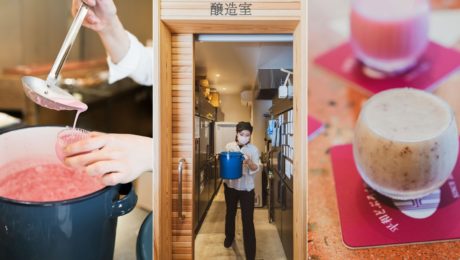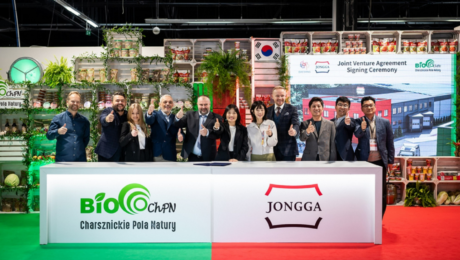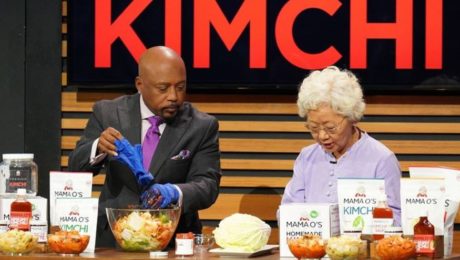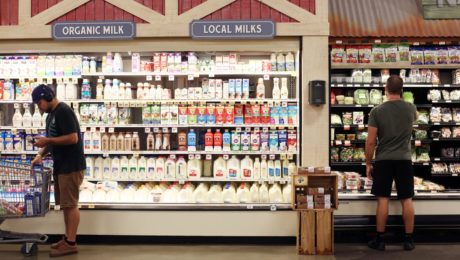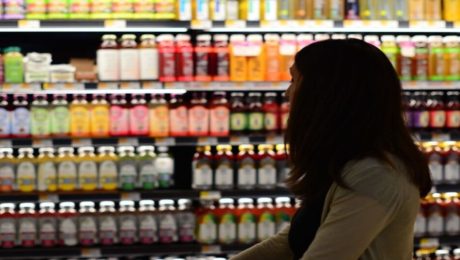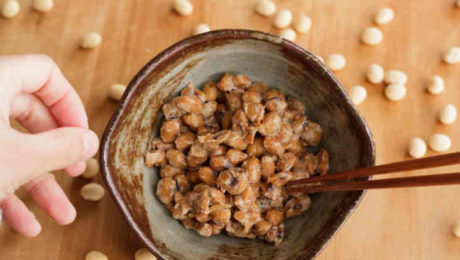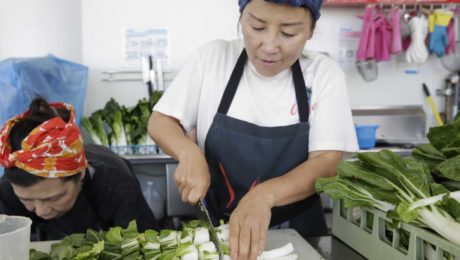French Baguette Added to Cultural Heritage List
The French baguette is as symbolic of France as the Eiffel Tower. The aromatic, golden, crusty bread has a deep flavor attributed to the long fermentation process.
And now the respected United Nations Educational, Scientific and Cultural Organization (UNESCO) Cultural Heritage of Humanity list – which includes other cultural fermented foods and beverages like champagne, kimchi and tequila – includes the French baguette. Specifically, the “artisanal know-how and culture of baguette bread.” President of France Emmanuel Macron calls it “250 grams of magic and perfection in our daily lives.”
“The traditional production process entails weighing and mixing the ingredients, kneading, fermentation, dividing, relaxing, manually shaping, second fermentation, marking the dough with shallow cuts (the baker’s signature) and baking,” UNESCO wrote. “Unlike other loaves, the baguette is made with only four ingredients (flour, water, salt and leaven and/or yeast) from which each baker obtains a unique product.”
The baguette is integral to the French way of life. More than six billion are baked every year in France, according to the National Federation of French bakeries.
The traditional baguette is taken seriously in France. It was officially given the name in 1920, a law specifying its minimum weight (80 grams) and maximum length (40 centimeters). An annual competition outside the Notre-Dame cathedral awards the best baguette baker in the country with a yearlong contract to serve the Élysée Palace, where the president lives.
“When a baby cuts his teeth, his parents give him a stump of baguette to chew off,” said Dominique Anract, the president of the National Federation of French Bakeries and Patisseries announced at the French Confederation of Bakers. “When a child grows up, the first errand he runs on his own is to buy a baguette at the bakery.”
The group led the effort to get the baguette on the UNESCO heritage list. The country was considering nominating the baguette, Paris’ gray zinc rooftops or the Biou d’ Arbois wine festival.
The news comes during a tumultuous time for artisanal bread. France is losing 400 artisanal bakeries a year since 1970, from 55,000 (one per 790 residents) to 35,000 today (one per 2,000). It’s been a significant hit to France’s rural areas, as supermarket chains overtake traditional, local bakeries.
French newspaper Le Monde points out that industrial bakeries are also putting mom-and-pop bakers out of business. Many consumers are swapping traditional baguette’s for modern favorites, like sourdough or burgers. Since 2017, sales of burgers in France have exceeded sales of jambon-beurre, the classic French ham baguette and butter sandwich.
After UNESCO’s announcement, the French government announced a Bakehouse Open Day to “enhance the prestige of the artisanal know-how required for the production of baguettes” and support new scholarships and training programs for bakers.
French bakers were skeptical. Parisian bakers told the New York Times after the announcement that their fears of high costs of wheat and flour (due to Russia’s ongoing war in Ukraine) would not be alleviated by the baguette’s new status.
“This UNESCO recognition is not what will help us get through the winter,” said Pascale Giuseppi, who was behind the counter of her bakery near the Champs-Élysées, serving a lunch rush for baguette sandwiches. “We still have bigger bills to pay.”
Read more (New York Times) & read more (Le Monde)
- Published in Business, Food & Flavor
Could Primeval Sake Variety Revive the Drink?
As Japanese consumers continue to swap beer, wine and cocktails over sake, the country’s national drink, industry experts think the doburoku sake variety could revive the dwindling sake market.
Doburoku is the catch-all term for sake that is unfiltered and gently carbonated. Described as rustic, cloudy and soupy, the drink’s brewing process doesn’t follow traditional sake rules. Brewers experiment with flavors, making it sweet or savory. It’s a “hyperlocal expression of soil and culture is its trademark,” reads an article on digital beverage publication Punch. Doburoku is typically unpasteurized, brewed in small batches.
There are only around 200 doburoku brewers in Japan, many who are farmers running small inns and restaurants. Only about two dozen of Japan’s 1,500 sake brewers make doburoku.
“At Heiwa Doburoku Kabutocho Brewery, the drink comes plain or aged, but also with unusual variations: dry-hopped, infused with matcha, mashed with persimmons, or blended with azuki beans, in part to tone down the alcoholic sharpness that many among sake’s detractors find off-putting,” continues the article. After fermenting the rice, koji and yeast for about two weeks, most of Heiwa’s doburoku is made in 7-liter pots in a backroom of the bar.
Norimasa Yamamoto, Heiwa Shuzou’s fourth-generation president, hopes to generate interest in sake by putting a “modern spin on the old-fashionred drink. …I’m hoping that, once you’ve tried doburoku, you’ll become curious enough about our rice fermentation tradition to delve into sake,” he says.
Read more (Punch)
- Published in Business, Food & Flavor
Poland Becomes Europe’s Kimchi Hub
The world’s largest kimchi producer – Daesang Corporation – is building their first European factory in Poland.
Daesang is investing $10.6 million to build the Kraków facility. It is a joint venture – called Daesang ChPN Europe – with Polish food producer Charsznickie Pola Natury (ChPN), who specializes in fermented foods. It will be the Korean company’s 11th overseas production facility – one facility is in the U.S. and the others are in China. They plan to produce 3,000 tons of kimchi a year.
“The Polish joint venture is yet another adventure for our attempts to globalize kimchi,” said Lim Jung-bae, CEO of Daesang. “We will do our best to promote the excellence and legitimacy of kimchi in Europe, following our efforts in the US.”
Kimchi is netting huge sales worldwide. Daesang dominates the export market – 60% of kimchi export sales are from Daesang. Their 2021 exports were $67 million, a 131% increase since 2016. European exports are increasing annually for the company at about 20%. The Netherlands and UK are the top European kimchi importers.
Read more (The Korea Herald)
- Published in Business
“Dairy is Ripe for Innovation”
As the dairy industry continues to suffer from low sales, could fermentation help the industry meet changing consumer needs? Functional dairy products (like fermented dairy) and animal-free precision fermentation products are major consumer trends for the dairy industry to adapt.
Functional dairy products are “ripe for expansion,” said Brad Schwan, vice president of Archer-Daniels-Midland Company, said brands have to invest in alt protein technologies to feed the future tech-savvy generation. Fermented dairy – like yogurt, kefir and fresh cheese – are all functional dairy.Fifty-eight percent of global consumers perceive a connection between gut function and other aspects of well-being. Consumers are looking for dairy with simple ingredient lists.
“The gut microbiome is a key growth area for functional, tailored offerings, as more consumers are making the link between their gut, digestive health and overall well-being,” Schwan added.
Consumers are looking for dairy with simple ingredient lists. They want their dairy to support pre- and post-workout goals, energy solutions, hydration, digestive support and immune function.
More consumers are embracing a mix of an animal- and plant-based diet. Fifty-two percent of consumers eat a flexitarian diet now.
Alt protein – once seen as a fringe biotechnology – is becoming more mainstream. Brad Schwan, vice president of Archer-Daniels-Midland Company, said brands have to invest in alt protein technologies to feed the future tech-savvy generation.
“While consumer acceptance of alternative solutions beyond plant proteins is still building, we foresee digital-natives Gen Z and Gen Alpha leading the way in the growing acceptance of novel methods and technologies,” he said in a report on global food trends. “Additionally, the dairy industry is ripe for more innovation in the coming year, through leveraging both new technologies…As consumers grow more accustomed to seeing novel proteins from unexpected places, the alternative dairy arena will flourish with new possibilities.”
Read more (Dairy Reporter)
- Published in Business
Shark Tank’s Blunder
Fans are upset after investors on Shark Tank turned down a deal on Mama O’s Premium Kimchi. The exposure, though, netted some big sales for the Brooklyn-based fermentation brand.
Founder Kheedhim Oh and his mom Myung Oh appeared on the show’s 14th season, which aired in October. Oh pitched an investment of $250,000 for 10% equity in the company. But none of the five sharks – four who had surprisingly never tasted kimchi – took the deal. Though kimchi is exploding in popularity in the U.S. (sales increased 90% last year), it illustrates that education is still needed for kimchi to achieve mainstream acceptance in the American market.
“Honestly, I thought they would be more hip to what is actually going on in the world and the wave that fermented foods is having,” Kheedim (a TFA Advisory Board member) said in an interview with TFA. “I was generally just surprised about the lack of general knowledge or interest in fermented foods. The show has made my mission even stronger to help people eat a more Korean diet with kimchi being an important part of it.”
Despite their rejection of the first fermented food to appear on the show, Kheedim said Mama O’s received a nice sales bump from the show. After the show aired, Mama O’s netted four months of business sales in seven days. There was another bump in sales after supermodel Bella Hadid shared on Instagram stories how disappointed she was that the sharks passed on Mama O’s.
“I’m very grateful to Shark Tank because it was a great opportunity to help demystify making kimchi at home using the Mama O’s Homemade Kimchi Kit,” he added.
On the segment, Kheedhim shared his story of beginning the Mama O’s brand with just $50 and a skateboard. Today, Mama O’s sells various kimchi flavors, kimchi paste, kimchi sauce and the make-your-own kimchi kit. Eight years since launching, Kheedim has never used outside investors, always putting his own profits back into the business. Sales were $815,000 in 2021 and will reach an estimated $1 million in 2022. The sharks were impressed with the profits. It costs the company $2.65 a bag to make the kimchi, but it retails for $8.99. The wholesale kits cost $8.25 to make, but sell for $20.
Kheedim – who had to sign an NDA so can’t provide many details about the process – told TFA that he spent months perfecting the pitch, but the live Q&A did not go as smoothly as he wanted. He accidentally handed out his Super Spicy kimchi variety for sampling instead of the classic, milder flavor. He was planning to use the money to hire a production manager, increase broker coverage and fund the brand’s move this month to a larger production space in Queens, New York.
Still, the show has been excellent exposure for Mama O’s. In addition to the sales bump, Mama O’s followers on social media increased and individuals and companies continue to reach out to Kheedim with business opportunities.
During the episode, Kheedim told the sharks how “kimchi is a health food but more importantly it tastes incredible and not just with Korean food either” like hamburgers, hot dogs and mac and cheese.
“What’s makes our kimchi the best is our authentic korean mom recipe,” Kheedim told the sharks.
Kheedim’s mom, Myung, 81, was a fan favorite. She shared how kimchi is an ancient superfood from korea, “naturally fermented and it is full of probiotics.” She also detailed how proud she is of her son, for being an “honest, hardworking entrepreneur who is passionate about kimchi.”
Ultimately, the sharks shared different reasons for not investing. Mark Cuban said he’s concerned Kheedim has been investing his own money back into the company. Lori Greiner says she loves kimchi but found Mama O’s “not investable.” Kevin O’Leary said, though he sees kimchi thriving in the health food space, “the hardest part of this is going to get people to actually try it.” Daymond John admitted he wasn’t “obsessed” with kimchi. Kendra Scott said she didn’t know what kimchi was.
Fans were not pleased. They took to social media to voice their opinion.
“Many entrepreneurs come and go, but only some define the season. What a positive spirit to the pitch. Wishing you all the success.” @umang.thareja
“You should have got the money. They are fools!” @lifebettergreen
“Sharks made a HUGE mistake by not investing. More people in America just need education on kimchi. You guys are going to kill it. Mama O was amazing.” @s.andersn
The day after airing, Kheedim made an Instagram post with the Anthony Bourdain quote: “Americans want kimchi. They want it on their hamburgers. It’s like when Americans started eating sushi. A huge tectonic shift. That funk. That corruption of the flesh. That’s exactly the flavor zone that we are all heading towards.”
Of note: in 2018 during the show’s second season, the sharks did invest in the Kombucha Shop, a DIY kombucha-making kit.
- Published in Business, Food & Flavor
Educating Consumers About Fermentation
Fermentation continues to top food trend lists, health movements and restaurant menus, influencing more curious consumers to buy fermented foods. But the average consumer remains fermentation clueless.
“Fermentation is a really complicated subject and we’re just reaching the tip of the iceberg at this point when it comes to the research,” says Jenna Mills, account manager at Eat Well Global, a food and nutrition consulting agency. “A complicated subject like this is loaded and I feel that individuals and consumer know just enough to be confused.”
Five food professionals shared their thoughts on how to educate consumers about fermentation during a panel at FERMENTATION 2022. Panelists included: Mills, Shannon Coleman (associate professor and state extension specialist at Iowa State University), Matt Lancor (CEO and founder of Kombuchade), and Kirsten Shockey (author, educator and co-founder of The Fermentation School and TFA Advisory Board member). Amelia Nielson-Stowell, editor at The Fermentation Association, moderated.
Simple Messaging
The panelists agreed fermentation brands need to stop overcomplicating fermentation to the consumer, focusing on simple communication strategies.
“I compare it to a small child asking where babies come from – a simple answer is enough,” says Shockey. “With fermentation, often, we’re ready to say that lactic acid bacteria come in and they’re eating carbohydrates and there are these metabolites and flavors involved. We’re ready to share all the details – and we’re met with a blank stare. People just often want to know what’s the difference between a pickle and a ferment.”
Shockey, who teaches at the women-run Fermentation School, says she’s felt pressure over the years to innovate her classes and teach new subjects. But, especially since the Covid-19 pandemic when more consumers focused on health and turned to fermentation, her most popular classes are still the basic fermentation 101.
In a TFA survey last year, 70% of fermentation producers said a greater understanding of fermentation and familiarity with the flavors associated with fermentation would foster increased consumption of fermented foods.
Kombuchade is taking a unique approach to that education component, focusing on kombucha as a recovery drink.
“I’m looking to make probiotics cool for athletes, much like Gatorade made electrolytes cool for athletes,” Lancor says. The science of food is typically a mechanical process: eat fats, carbohydrates and proteins for optimal energy and performance. “There’s actually a microbial fermentation process that’s helping to rebuild your muscles.”
Kombucha marketing is geared toward a yoga, enlightenment crowd, Lancor adds, only reaching a certain number of consumers. It doesn’t resonate with all consumers.
“The south side of Chicago guys that play on my rugby team, they were never going to grab that kombucha bottle off the shelf with that kind of messaging,” he says. “There wasn’t this message of probiotics can be used for performance or recovery or even understanding kombucha’s place within an athlete’s regimen.”
Communicating Science & Tradition
Fermented food brands are tasked with bridging the gap between science and consumer.
Consumers keep informed about food and nutrition trends through professional associations (69%), academic (67%) and dietitians and nutritionists (62%), according to a consumer insights survey by Eat Well Global.
For 77% of consumers, the advice of dietitians and nutritionists impacts which foods they buy. Mills says healthcare professionals offer that counseling on how to incorporate fermented foods into the diet.
Don’t forget the ancestral wisdom, Shockey points out.
“My one liner is we’ve evolved with these foods and you are here because your ancestors successfully fermented,” she says. Rather than educating that people should eat a tablespoon of sauerkraut a day to meet nutrition needs, “try to bring it into your world naturally.” Eat a mixture of ferments, with yogurt at breakfast or hot sauce at lunch and kimchi at dinner.
“We cannot put ferments into this box that must be eaten raw. That to me is a barrier. You should eat this in any way that feels right to you,” she says, adding ferments were traditionally eaten cooked in soups and stews. “But in our minds right now is the idea that we have to eat our probiotics raw. These foods have so many metabolites that are being created in production and they follow through in the cooking process.”
Challenges to Starting a Brand
Starting a fermentation brand can be an overwhelming task. Sandor Katz, fermentation author and educator, said in his keynote address at the FERMENTATION 2022 conference that education is a huge challenge for people launching new fermented products.
“They often end up putting a lot of their energy into educating consumers,” he says.
Coleman says state extension offices are an underutilized resource for new producers. Her office got into food preservation after noticing many Pinterest recipes that gave poor advice on food safety.
“Just about every extension program has some form of food preservation type of program that they are delivering to consumers and they want to help,” Coleman adds.
There are no universal standards for labeling, an obstacle for new producers.
“Labeling is such a sensitive issue because you can get into big trouble with the FDA,” Nielson-Stowell says, pointing out the U.S. Food & Drug Administration only has 12 approved health claims a brand can put on a label. “It also gets tricky putting ‘probiotic,’ ‘prebiotic’ or ‘postbiotic’ on a label. It’s not regulated and confusing to consumers.”
The International Scientific Association of Probiotics & Prebiotics (ISAPP) is pushing for -biotics to be a more protected term. According to ISAPP, only fermented food brands with a scientifically measured -biotic should but it in a label. Their health benefits must be documented. For example, yogurts often have defined probiotic strains on their labels.
Nielsen-Stowell recommends using “live cultures,” “live microbes” or “naturally fermented” instead. And make sure retailers know what that means.
“If you’re getting your set in store with a retailer, the retailer will be your biggest advocate. The retailer is going to be the one talking to the customers more than you. Educate them. Do they know why your product is better than your competitor’s product?” she adds.
Lawsuit Alleges Kombucha Exceeds Alcohol Limit
Four consumers — three underage — filed a lawsuit alleging Tribucha Inc. misled them into buying non-alcoholic kombucha that contains twice the alcohol permitted for non-alcoholic beverages.
The 30-page class action lawsuit contends Tribucha has been sold to “unsuspecting children, pregnant women, persons suffering with alcohol dependence issues, and a host of other people for whom alcoholic consumption may pose a grave and immediate safety and/or health risk.” The lawsuit says the North Carolina-based brand has a small disclaimer on the label stating that Tribucha “contains a trace amount of alcohol,” but an investigation proved otherwise. Plaintiffs used a lab accredited by the Alcohol and Tobacco Tax and Trade Bureau (TTB) to test the kombucha and found it is over 0.5% alcohol by volume, which classifies it as alcoholic.
The complaint continues: “Because Tribucha Kombucha does not include any warnings concerning the significant presence of alcohol, consumers, including Plaintiffs, are led to believe that the products are safe to consume when driving a car, operating machinery, and taking with potentially a deadly cocktail of incompatible medications.”
In 2010, Whole Foods and other retailers pulled kombucha off shelves as the TTB investigated whether alcohol levels in kombucha were higher than what was printed on the label. And since then, consumers — and even other brands — have filed lawsuits against various kombucha brands, alleging alcohol levels higher than indicated.
Kombucha can keep fermenting after it’s made, as the yeasts continue to eat sugars. Under current law, if kombucha leaves a processing facility at 0.4% ABV, but increases to over 0.5% by the time it’s placed on grocery store shelves, the brewer would have to pay federal alcohol taxes like a beer brand.
Kombucha producers fear constant repercussions from this law, says Hannah Crum, co-founder and president of Kombucha Brewers International (KBI), the trade organization for kombucha brewers.
Earlier this year, South Carolina’s Department of Revenue (DOR) categorized all kombuchas as alcoholic beverages. The state’s regulations set a maximum alcohol content for beverages but no minimum, so any fermented beverage with any alcohol content would be considered alcoholic. Since kombucha fermentation produces a trace amount of alcohol, a brewer would need to apply for a state alcohol license, and kombucha could not be sold to anyone under the age of 21. It contradicted the U.S. legal definition of an alcoholic beverage.
After kombucha industry leaders contacted the state’s DOR and the South Carolina Retail Association (SCRA) to share advice and resources, the regulation was amended to exempt kombucha. KBI’s leadership and legal counsel, along with producers Buchi Kombucha, GT’s Synergy Kombucha, Health Ade, Humm and Brew Dr. were involved.
Pending in Congress is the KOMBUCHA Act, legislation that would make kombucha beverages exempt from excise taxes intended for alcoholic beverages. The act proposes to raise the alcohol by volume (ABV) threshold for kombucha from its current level of 0.5% to 1.25%.
Reads a statement from KBI on the act: “These laws were never intended to make kombucha subject to taxes designated for beer. Passing the KOMBUCHA Act under the next appropriations bill will relieve this unnecessary burden on kombucha brewers. Only kombucha above that level (1.25%) will be subject to federal excise taxes when this Act becomes law.”
KBI has actively lobbied for the bill’s passage. Big kombucha brands (GT’s and Health-Ade) have actively supported the bill.
- Published in Business
PBS Features HEX Ferments
Baltimore-based HEX Ferments was the star of the PBS show START UP. The series highlights small American business owners, chronicling what it takes to start a successful business.
During the episode, HEX Ferments co-founder Maegan Carpenter schooled START UP host Gary Bredow on ferments and gut health. She explained how the modern gut microbiome has been eroded by antibiotics, but fermented foods help to populate and repopulate the digestive system with good bacteria.
“What you’re getting essentially is a vegetable that’s been fermented in a blanket of bacteria that’s indigenious to our bodies: lactobacillus,” Carpenter explained, while Bredow sampled HEX’s seasonal Spirit Berry kombucha and Pizza Kraut sauerkraut.
A former art professor, Carpenter and her co-founder husband Shane, a former wedding photographer, never planned to start a fermentation business. Carpenter began teaching people how to use produce from their local community garden, offering tastings of the vegetables she fermented. Orders for her ferments started showing up in her mailbox. Carpenter said she thinks the demand came from “being open with people and showing people something that has been taken out of our culture for so long.”
Bredow added about modern food convenience: “It’s scary to think about if that convenience goes away, are we going to have a society of people incapable of watching food rot right in front of them.” Carpenter responded: “I think we already do.”
HEX Ferments will be expanding into a new, larger retail space later this year, HEX Superette. The space includes a kombucha taproom, small restaurant area to serve small plates, space to teach education classes and a local food marketplace. HEX Superette, Carpenter said, will “answer the question, ‘How do I eat this?’ because after 10 years of making fermented foods, we often get that question.”
Bredow concluding the episode noting that fermentation was born out of food scarcity, something today’s generation did not understand until the Covid-19 pandemic.
“Our ancestors planned for the future knowing that self sufficiency can mean the difference between life and death. Maybe it’s time to revisit the skills that allowed past generations to live with less fear and reliance on a system that always seems to be on the brink of collapse,” Bredow said. “I love what Meghan and Shane are doing. They’re not only offering up tasty and healthy foods, they’re reminding us how important it is to learn this lost craft before it’s too late…they’re offering fermentation classes. To me, this really is purpose. A focus on doing well and doing good for the world around them.”
- Published in Business, Food & Flavor
Pass the Protein Powder – and the Ferments?
Fermented foods can aid in muscle growth.
“A growing body of research suggests gut-friendly foods enhance muscle growth and could even take a bite out of age-related decline,” reads an article in Men’s Health.
As we age, the body slows down, reflexes decrease and muscle mass decline — especially difficult changes for professional athletes. The average person loses 5% of muscle mass per decade after reaching 30, leading to diminished mobility and heightened risk of falls. Exercising consistently is key to keep muscles strong. But equally important, research shows, is maintaining a healthy gut microbiome. New research – published in the journal Nutrition and Metabolic Insights – found mice with an artificially depleted microbiome from antibiotics had significantly slower muscle growth than the control group.
“In short, muscles really are built in the kitchen – at least, to a greater degree than you might have suspected,” the article continues.
The article points to the ground-breaking Stanford study that found a diet high in fermented foods boost microbiome diversity. The article concluded with four fermented food swaps “to make your gains last.” These include: swapping yogurt for kefir, swapping green beans for natto, swapping pickles for kimchi and swapping ketchup for miso.
Read more (Men’s Health)
- Published in Business
SF’s Vegan Kimchi Queen
Aruna Lee’s path to running a fermented food brand is riveting, from her journey as an orphan to Buddhist nun to founder of Volcano Kimchi.
Lee’s story is detailed in a San Francisco Chronicle feature. Adopted by her teacher, she remembers sneaking out of bed in the middle of the night and digging up dongchimi, a winter radish kimchi fermented in large crocks buried in the ground. Later, as a nun in seminary school, Kimchi was communally made during gimjang, the process of kimchi making. The members of the monastery would prepare bulk batches in winter and spring in a large bathtub, storing it in underground crocks.
Curious about the world, Lee later left the monastery and traveled the world. She met her husband and eventually made roots in San Francisco. After the recession forced her to leave her career in the nonprofit sector, she began making kimchi for sale at farmers markets in 2014 without any professional cooking experience. Her organic kimchi is made similarly to how she learned in the monastery — including keeping it vegan.
“When you add fish sauce and shrimp paste, it overpowers everything and you don’t taste each ingredient. When you add simple ingredients, it’s balanced. It has a harmony of that flavor,” Lee says.
Read more (San Francisco Chronicle)
- Published in Business, Food & Flavor


